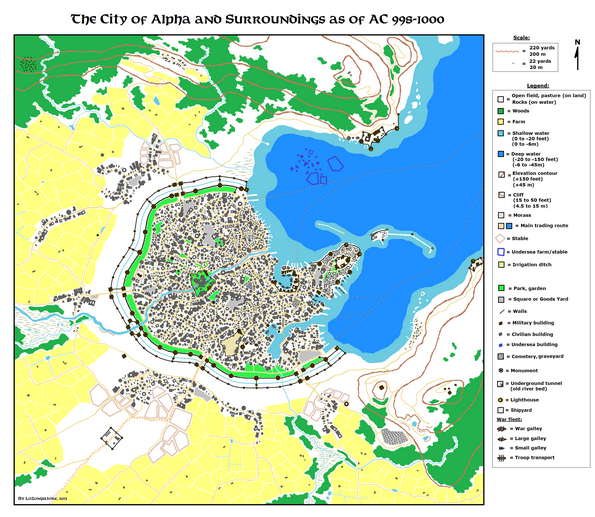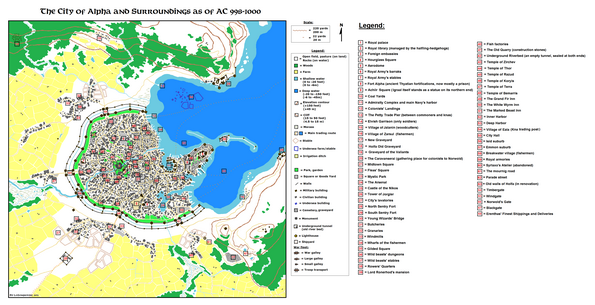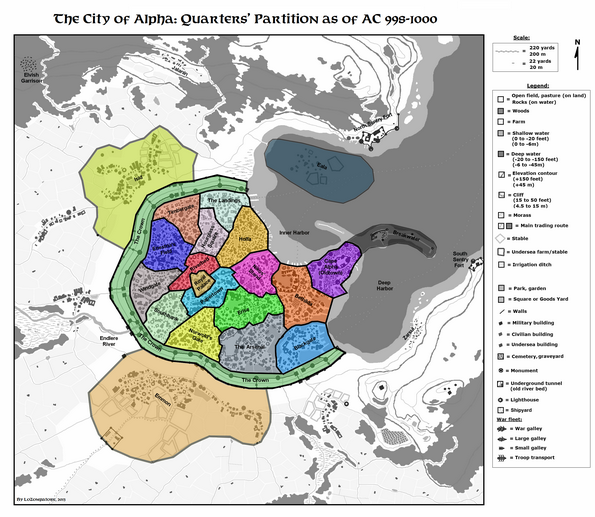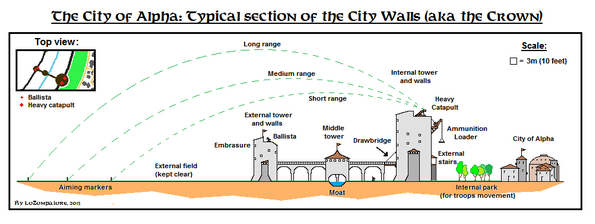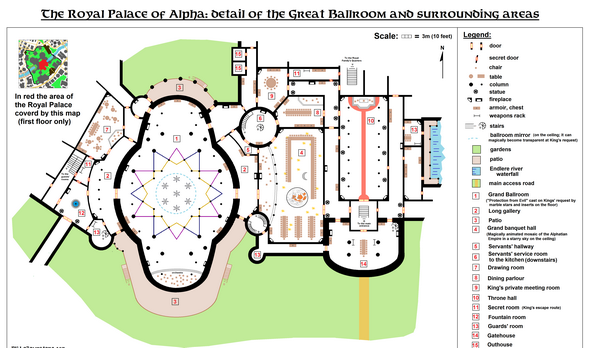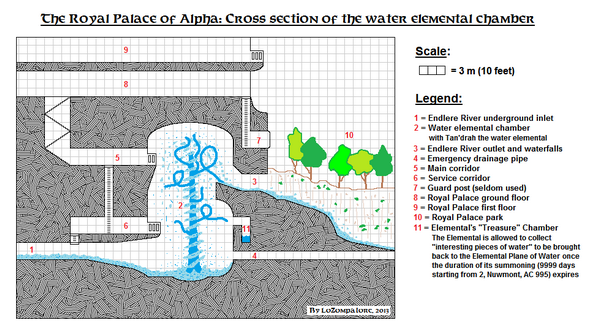
A city of Alpha mini-Gaz
by LoZompatoreome months ago I was going to add some depth to the city of Alpha in Norwold as I wished to set a campaign there. Then things got a little too far and everything ended up with the map pack you find below.
I share it with you in case it might be useful for your adventures as well. Most of it is non-canon, of course, but I tried to stay true to what can be found in CM1 and the other few official modules which give any further detail (basically M2, PWAI and GAZ9 - about armies, fleet and trades, Rogues to Riches novel and a single note in M5 about "Bethilda's Star", the ship of King Ericall).
I also tried to merge the fan made material i found here, and here, and also here but there was still plenty of room for improvisation.
I'm going (hopefully) to better detail the various entries you see in map #2 but, up to now, I'm afraid you'll have to content with the maps' legends and the storyline I outlined at the bottom of this post which, I hope, will help to explain many of the less obvious locations.
By the way, there is also room for fan-made contributions! If you have any idea for specific locations just make your suggestion and I will be glad to include it in the map!
Said enough, here is the map pack:
1) The city of Alpha (clear map):
2) The city of Alpha (with notes):
3) City Partition into quarters:
4) A typical section for the City Walls:
5) Detail of the Great Ballroom in the Royal Palace:
6) The subterranean elemental chamber:
In the following there is an introduction to this detailed city of Alpha, the city storyline I introduced you before and an estimate of the city's garrison during peacetime. Enjoy!
Foreword:
The city of Alpha described in the following is a large, bustling city of 30'000 people (and growing) in which the Empire of Alphatia made a major building effort in the last 15 years. Alpha is the key to Norwold settlement, by far the most important colonists' gathering point, military garrison, trading hub and manufacturing center in the whole region. Should the city be conquered, the whole Alphatian effort of colonization in Norwold will be frustrated.
For this reason the city was built by Alphatian planners with impressive defensive walls and structures, while enough room was left inside the city walls for further urban developments. The number of buildings in Alpha may easily double without the need to enlarge the city walls or the risk of overcrowding the city.
Another effort is being done in attracting the Alphatian and foreigners' elites to the city. The Royal Palace is a beautiful work of art in itself, parks and gardens with fountains and other water amusements were built throughout the city; an arcane city quarter is going to be established in the northwestern sector of the city, with the hope to attract young and enterprising mages from the mainland; large freedom of cult is granted and new temples are built along with the old ones. Tolerance towards strangers and non-magic users is encouraged with the hope of building a unified society. Artists were hired from the metropolitan territory to embellish the urban landscape with statues and fine monuments. This last effort, still ongoing, is somewhat less successful than the other ones, but hopefully things will change in the not too far future.
History of Alpha:
(canon + Zendrolion's Norwold timeline here + many personal add-ons)
The Thyatian Colony and the Alphatian curse:
A first settlement called Cape Alpha was founded by the powerful Alphatian prince Alinor of Haven around BC 120, as a bridgehead for further inland penetration. After the establishment of Alinor's the capitol city of Alphia the settlement of Cape Alpha became just a secondary seaport, further declining during the war between Alinor and the Wyrmsteeth dragons around 50-30 BC. Alpha survived the destruction of Alinor's kingdom and later barbarian incursions just to be conquered by Thyatians in AC 12, turned into a fortified settlement and subsequently "liberated" by the Alphatians in AC 15. A peace treaty between the two empires leads to the cursing of Alpha by the hands of the Alphatian Council.
A powerful spell was unleashed on the town which would trap any trespasser inside the perimeter of the city walls. A demi-intelligent, strong golem called Igraal was created by three Alphatian archmages and placed inside the town with the task to hunt and kill every living being on sight. The souls of those killed in the cursed town were prevented to leave the walls' perimeter as well (turning them into undead of various power), thus increasing the dangers for those wishing to enter the ruins. The curse could be lifted only if a pure-blood Alphatian, while inside the city walls, pronounced a specific magic word. The word was known only by the golem - as it was the name of the first thing the golem saw once it became self-conscious following its own creation. The golem had no reason to speak or to exit the city walls, as its task was confined solely to the area of old Cape Alpha. Igraal was also magically anchored to Cape Alpha's castle, and it was not possible to teleport it away from the city. Moreover, having no true brain of its own, it was also impossible to read the word from its mind using divination spells and the like.
The curse also created a very powerful anti-magic area inside the old city walls, so it was not possible to use magic to attack the golem or teleport people in or out the city walls. Finally, the curse prevented all the undead inside the city to be destroyed - but not turned - by clerical powers.
The original population of the city, a mix of Thyatians, Alphatians and Antalian-descended people re-settled nearby and slowly established the fishermen’s' town of Holfa (in itself an Antalian corruption of the word "Alpha"). Within a few years the two empires lost interest in the area as the curse prevented any access to the best part of Cape Alpha's natural deep water harbor, while Holfa and surroundings were simply not worth the expenses of a campaign of conquest.
The dark dominion of Akra the Ice Witch:
In AC 170 Holfa and its surroundings were conquered by the armies of the Ice Queen Frota, and were forced under her oppressive rule until the three crones of Crystykk defeated her in AC 336. During Akra's rule packs of demi-intelligent ice wolves loyal to the witch patrolled the town searching for rebels. Ice wolves are still feared and hated as of today among descendants of the original Holfans.
Volospin III's colonization attempt:
Between AC 450 and AC 510 the colonization attempts of the Great Bay performed by the Alphatian emperor Volospin III brought new wealth to Holfa, which was incorporated into the new colony as an important stop on the supply route to the main settlements on the Sabre river. It was during this time that the knas began establishing their underwater villages offshore the peninsula of Alpha. The under water outpost of Eala followed shortly after. After the failure of Volospin III's efforts following the defeat of the Alphatians on the Sabre river battle of AC 506 the Alphatians retired again from Norwold and in the following decades Holfa suffered raids and occupations by several barbarian warlords who established short-lived petty dynasties.
Frota, the heiress of Akra and the first of the Nikos:
In AC 847 Holfa was conquered by Frota, a witch who had re-discovered most of old Akra's sources of power and who had managed to use them to build a short-lived empire of her own. The witch was defeated in AC 874 thanks to a massive insurrection of her most of her subjected people. Nikos, a hero of long-lost Thyatian descent, was instrumental in freeing the town of Holfa from the army of Frota's lieutenant, the evil barbarian cleric Alequa. Nikos was helped by a tribe of hybrid halfling-hedgehogs from northwestern Norwold: after Alequa's defeat many of them moved to Holfa establishing a monastery there.
Nikos was appointed "Lord and Protector" of the town and effectively ruled it as a benign feudal lord, establishing a dynasty called "the Nikos".
Jorgler the tyrant and the challenge with Enestria:
Two generations later (AC 933), Nikos great-grandson, a hot-headed, magic-talented young called Jorgler used his magic powers to kill his own father Hullic and he became the new despot of Holfa. He built for himself a large tower outside the city and heavily damaged the family's castle, as he did not want it to be used as a strongpoint for a rebellion. He was obsessed with entering the ancient Cape Alpha complex and defeating Igraal but he never managed to figure out a way to do it without losing his life. In the meantime he acted as an oppressive ruler, heavily taxing the population and expropriating anything of value in order to get more resources for his magic experiments.
Fear for Jorgler great powers prevented any successful rebellion until in AC 968, an accomplished mage named Enestria came from the Empire of Alphatia.
Enestria moved to Holfa out of curiosity for the ancient curse set on Cape Alpha. There she discovered Jorgler's misdeeds and she decided to challenge him (likely also to seize the results of his studies). An epic battle of magic, which lasted over two days, ensued on the lands around Jorglers' tower. The battle had a sudden end when both rivals simultaneously disappeared: it is widely believed they moved their battle to other planes of existence as none of them seemed tired or close to lose before the disappearance. Whatever, they never returned (so far) and the town was again free.
Bethilda and the lift of the curse:
The events took a major turning point in AC 973 when Bethilda, a young cleric-thief of Holfa, managed to enter Jorgler's tower (sealed until the end of the battle with Enestria) and stole his researches on Cape Alpha. She studied his documents and immediately left the town, adventuring for the next 10 years. In AC 983 she came back with a young guy from Alphatia called Oressen, her backpack full of lore and information about Cape Alpha.
She approached the town council and persuaded them to make an attempt to leave the curse on the ancient settlement (the town council was troubled with overpopulation issues, the suburb of Emmon being established a few years before). At first long range catapults were moved and launched boulders to a selected spot on Cape Alpha city walls, creating a small dead-end bay which could be reached only from outside. She them trapped herself inside the bay and with the help of the whole clergy of Holfa, she turned away all the ghosts-like undead who approached her across the city wall. She then waited for the golem, waiting for the golem and turning away the ghosts of those trapped inside the cursed city.
When Igraal inevitably arrived, passing outside the city walls to reach and kill her, she activated a powerful "Contingency" spell Holfa's population acquired at great cost and which was prepared in advance on the external ground close to Bethilda's location. The spell trapped the golem, who could free itself only by pronouncing the magic word which would end the curse. So, in order to free itself and kill Bethilda, the golem uttered the word - which turned out to be "Achiir", the Alphatian name of a southern star not visible from Cape Alpha latitudes - but, with a glimpse of trickery in its semi-conscious mind, Igraal said the word so quietly that only Bethilda in the niche of the city walls was able to hear it.
A short but violent fought ensued, in which Igraal horribly started shouting aloud and tried to strangle Bethilda in order to prevent the magic word to be communicated to others, while Bethilda tried to dodge the golem and tell the magic word to Oressen - which was a pure-blood Alphatian brought there by the girl just for the purpose of lifting the curse.
The golem really had no hope to succeed: Oressen and a strong group of warriors and magic users from Holfa approached the golem and, while fighting the creature, managed to hear Bethilda's word. While Oressen was escorted in town to lift the curse, the rest of the fighters prevented the golem to reach the pure-blood Alphatian. Many died in this effort, including the severely wounded Bethilda, but, in the end, the curse was lifted from Cape Alpha.
As soon as Oressen uttered the magic word inside the city walls, the golem instantaneously deactivated and never moved again (it was later moved on a large square inside the old Cape Alpha city walls to act as a monument: whether it could be activated again or not is a matter of scholars and sages). The souls of those killed in the city were freed as well and moved to other planes of existence; what could be found of their mortal remnants scattered throughout the city was buried with the corpse of Bethilda and other fighter who died in the endeavor not far from Cape Alpha city walls in a place later called "Graveyard of the Valiants". At last Cape Alpha could be settled again.
Renewed colonization efforts by Alphatia:
The opportunity to establish a thriving base on Cape Alpha led to a renewed effort from both empires to colonize Norwold. Thanks to Imperial tireless diplomatic efforts during the tenth century AC, many communities (including Holfa) already sympathized with Alphatia, so Empress Eriadna declared most of Norwold as a new Alphatian kingdom and started a massive colonization campaign. In AC 985 Holfa-Cape Alpha became the new capital of the kingdom (with the name of Alpha) and the Empire's best talents were dedicated on converting the place in the largest and most well-defended city of the whole region. Massive city walls were erected around a large swath of territory, surrounding enough land to room 60'000-70'000 people (up to 100'000, assuming a crowded urbanization), a population level the Imperial demographists estimate will be reached around AC 1020. The monumental Royal Palace was laid down in this period as well: the Endlere river was deviated to create a waterfall and other water amusements in the Royal Gardens, all powered by a summoned water elemental hidden in the castle's dungeons. Artists and talented architects were called throughout the Empire to help beautifying the new city.
Noticeable among those artists were an odd group of students from the Sundsvall University who built the high and slender Bridge of the Young Mages across the arsenal's channel and Syrlaxo the Colossal, a mage-artist from the city of Symmetria in the Alphatian kingdom of Haven who dispersed huge statues of humans and animals throughout Alpha, only to mysteriously disappear (AC 991) shortly before the beginning of what he called "his unequalled obsidian masterpiece" (today large shards of obsidian are found throughout his abandoned workshop, but the "masterpiece" is nowhere to be found).
The present:
Ericall, the son of empress Eriadna, was appointed king of Norwold in AC 992. By AC 995 the bulk of fortifications and the Royal Palace were completed. In late AC 998 Ericall declared that a Landgrab would be held in Alpha during the spring of the following year, in order to assign wilderness fiefdoms to the most renowned adventurers and heroes of the world and speed up the colonization of Norwold wilderness. In the meantime Thyatian agents and spies (like Erenthas the elf, who owns a wealthy shipping and deliveries business in Alpha) infiltrated the kingdom, waiting for the right moment to help Thyatis to claim back its old Cape Alpha colony once more.
Military garrisons:
Alpha is a heavily fortified city as, should it fall, the whole colonization effort of Norwold would inevitably fail.
The numbers below refers to peacetime conditions. They double during wartime conditions (excluding city militias who could eventually be created).
The following numbers are assumed to represent the garrison part of the "mobile" miltary units listed as "Royal army of Norwold", "Royal fleet of Norwold" and "Queen's guard"(plus a few minor military units) described in CM1 and M2 modules.
Royal Palace: 20 archers, 50 swordsmen, 12 horsemen, 4 officers, 20 horses
Aerodome: 10 archers, 10 swordsmen, 1 officer, 50 imperial soldiers (mixed) from mainland Alphatia
Royal army barraks: 100 swordsmen, 80 horsemen, 4 officers, 10 horses
Royal army stables: 10 swordsmen, 10 horsemen, 1 officer, 50 war horses
Fort Alpha: 10 archers, 50 swordsmen, 15 horsemen, 3 officers, 20 horses
Other Cape Alpha fortifications: 6 archers, 4 officers, 75 marines (in reserve), 35 sailors (in reserve), 80 rowers (in reserve)
Admiralty complex and Navy harbor: 4 archers, 5 officers, 100 marines (in reserve), 35 sailors (in reserve), 200 rowers (in reserve)
Elvish garrision (allied to Alpha): 30 elvish archers and 10 elvish swordsmen, 1 officer
The arsenal: 10 swordsmen, 1 officer
Castle of the Nikos: 4 archers, 22 swordsmen, 1 officer
North Sentry fort: 10 archers, 50 swordsmen, 10 horsemen, 2 officers, 20 horses
South Sentry fort: 10 archers, 50 swordsmen, 10 horsemen, 2 officers, 20 horses
Rower's quarters: 3 officers, 350 rowers (in reserve)
City Hall: 6 archers, 6 swordsmen, 1 officer
Royal armories: 10 archers, 20 swordsmen, 25 horsemen, 3 officers, 34 horses
City walls (outer ring - 40 small towers): 40 archers, 30 swordsmen, 10 horsemen, 6 officers, 20 horses
City walls (inner ring - 20 large towers): 40 archers, 40 swordsmen, 20 horsemen, 6 officers, 40 horses
City gates (4 gates - 16 large towers): 20 archers, 32 swordsmen, 8 horsemen, 4 officers, 16 horses
Other fortifications outside the city walls: 10 archers, 20 swordsmen, 4 officers
Eala underwater trading outpost (allied to Alpha): 20 knas, 15 tritons, 5 merrows, 25 seahorses
For a grand total of:
1921 soldiers (200 archers, 500 swordsmen, 200 horsemen, 56 officers, 175 marines, 70 sailors, 630 rowers, 40 elves, 40 underwater dwellers and 50 imperial guards) + 250 horses and 25 sea horses.
